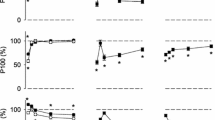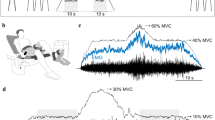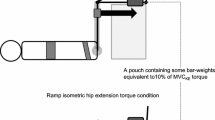Abstract
To assess the extent of the level of muscle activation during maximal voluntary effort, a method of superimposed trains of electrical impulses delivered at 100 Hz was employed. During a maximal voluntary contraction (MVC) in isometric knee extension, a submaximal superimposed electrical stimulation (ES) of differing train durations was induced to the quadriceps muscle, when maximal voluntary torque was achieved. For all train durations the force increased during ES. During 100 ms and longer trains, the additional torque reached a plateau. The same principle of submaximal electrical stimulation superimposed over MVC was used in explosive isometric knee extensions, comparing the rate of force growth in trials with and without ES. In all subjects ES had an augmenting effect during the increase in force and up to the maximal force. It was concluded that the subjects were not able voluntarily to activate fully their quadriceps muscle. This was true both for maximal force and for the increase in force. It seems that the existence of an activation deficit is a fact, the question is how to quantify it in a reliable and valid way.
Similar content being viewed by others
References
Adams GR, Harris RT, Woodward D, Dudley GA (1993) Mapping of electrical muscle stimulation using MRI. J Appl Physiol 74:532–537
Alexander R, Vernon A (1975) The dimensions of the knee and ankle muscles and the forces they exert. J Hum Mov Stud 1:115–123
Allen GM, McKenzie DK, Gandevia SC, Bass S (1993) Reduced voluntary drive to breath in asthmatic subjects. Respir Physiol 93:29–40
Belanger AY, McComas AJ (1981) Extent of motor unit activation during effort. J Appl Physiol 51:1131–1135
Bigland-Ritchie B (1981) EMG and fatigue of human voluntary and stimulated contractions. In: Porter R, Whelan J (eds) Human muscle fatigue: physiological mechanisms. Pitman Medical, London, pp 130–148
Buehrle M, Schmidtbleicher D (1981) Komponenten der Maximalund Schnellkraft-Versuch einer Neustrukturierung auf der Basis empirischer Ergebnisse. Sportwissenschaft 11:11–27
Chapman SJ, Edwards RHT, Greig C, Rutherford O (1984) Practical application of the twitch interpolation technique for the study of voluntary contraction of the quadriceps muscle in man. J Physiol 353:3P
DeLuca CJ, LeFever RS, McCue MP, Xenakis AP (1982) Behaviour of human motor units in different muscles during linearly varying contractions. J Physiol 329:113–128
Dietz V, Schmidtbleicher D, Noth J (1979) Neuronal mechanism of human locomotion. J Neurophysiol 42:1212–1222
Dowling JJ, Ljucovic P, Andrews DM (1993) Predicting maximal muscle force via the interpolated twitch. Proceedings of the 14th Congress of the International Society of Biomechanics, Paris. Available from Laballery, Clamecy, pp 348–349
Edwards RHT, Hill DK, Jones DA (1975) Heat production and chemical changes during isometric contractions of the human quadriceps muscle. J Physiol 251:303–315
Gandevia SC, McKenzie DK (1985) Activation of the human diaphragm during maximal static effort. J Physiol 367:45–56
Garnett R, Stephens JA (1981) Changes in recruitment threshold of motor units produced by cutaneous stimulation in man. J Physiol 311:463–473
Goldberg AL, Etlinger JD, Goldspink DF, Jablecki C (1975) Mechanism of work-induced hypertrophy of skeletal muscle. Med Sci Sports Exerc 7:248–261
Gollnick PD, Karlson DJ, Piehl K, Saltin B (1974) Selective glycogen depletion in skeletal muscle fibres of man following sustained contractions. J Physiol 241:59–67
Haekkinen K, Komi PV (1985) Changes in electrical and mechanical behaviour of leg extensor muscles during heavy resistance strength training. Scand J Sport Sci 7:55–64
Hales JP, Gandevia SC (1988) Assessment of maximal voluntary contraction with twitch interpolation: an instrument to measure twitch responses. J Neurosci Meth 25:97–102
Henneman E, Samjen G, Carpenter DO (1965) Functional significance of cell size in spinal motoneurones. J Neurophysiol 28:560–580
Ikai M, Fukunaga T (1970) A study on training effect on strength per unit cross-sectional area of muscle by means of ultrasonic measurements. Int Z Angew Physiol Einsch Arbeitsphysiol 28:173–180
Jones DA, Rutherford OM (1987) Human muscle strength training: the effects of three different regimes and the nature of the resultant changes. J Physiol 391:1–11
Kocesa AM, Kamen G (1988) Conditioned patellar tendon reflexes in sprint- and endurance-trained athletes. Med Sci Sports Exerc 20:172–177
Massalgin NA, Uschakow IW (1979) Anwendbarkeit der Elektromyografie zur Beurteilung des Entwiklungsniveaus zentralnevraler Faktoren, die die Effektivitaet der Schnellkraftbewegungen beeinflussen (translation). Med Sport 19:364–366
Merton PA (1954) Voluntary strength and fatigue. J Physiol 123:553–564
Noth J (1992) Motor units. In: Komi PV (ed) Strength and power training in sport. Blackwell, Oxford, pp 21–28
Sale DG (1988) Neural adaptations to resistance exercise. Med Sci Sports Exerc 20:5135–5145
Sale DG, Martin JE, Moroz DE (1992) Hypertrophy without increased isometric strength after weight training. Eur J Appl Physiol 64:51–55
Schmidtbleicher D (1987) Motorische Beanspruchungsform Kraft. Dtsch Z Sportmed 38:356–377
Sinacore DR, Delitto A, King DS, Rose SJ (1990) Type II fibre activation with electrical stimulation: a preliminary report. Phy Ther 70:416–422
Strass D, Strojnik V (1991) Die Wirkung von Elektrostimulation auf maximale Kraftverhalten. Dtsch Z Sportmed 42:574–580
Strojnik V (1993) Non-invasive diagnostics of neuromuscular function with electrical stimulation. Proceedings of the 3rd Symposium of International Society of Sport Motorics. Poznan. Available from Akademia Wychowania Fizycznego, Poznan, pp 279–283
Strojnik V Absolute muscle force determination. Proceedings of 12th International Symposium of Biomechanics in Sports, Budapest-Siofok. In press
Strojnik V, Strass D (1993) Effects of additional submaximal electrical stimulation on velocity of movement in fatigue. Proceedings of the 14th Congress of International Society of Biomechanics, Paris. Available from Laballery, Clamecy, pp 1296–1297
Tremblay LE, Belanger J, Laganiere L, Viau J, Lessard Y (1993) The tetanizing neuromuscular electrical stimulation (NMES) of the contralateral quadriceps (QS) muscle modifies the excitability of the ipsilateral QS. Proceedings of the 14th Congress of International Society of Biomechanics, Paris. Available from Laballery, Clamecy, pp 1362–1363
Wuerker RB, McPhedran AM, Henneman E (1965) Properties of motor units in a heterogeneous pale muscle (m. gastrochnemius) of the cat. J Neurophysiol 28:85–99
Yemm R (1977) The orderly recruitment of motor units of the masseter and temporal muscles during isometric contraction in man. J Physiol 256:163–174
Author information
Authors and Affiliations
Rights and permissions
About this article
Cite this article
Strojnik, V. Muscle activation level during maximal voluntary effort. Eur J Appl Physiol 72, 144–149 (1995). https://doi.org/10.1007/BF00964129
Accepted:
Issue Date:
DOI: https://doi.org/10.1007/BF00964129




